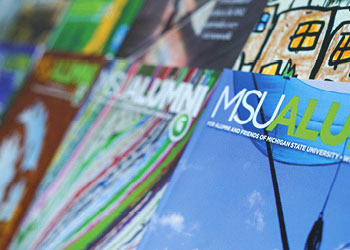Sports: A Positive Debut for John L. Smith

Can John L. Smith return MSU football to its glory days with a wide-open offense? Spartan fans await the answer.
After John L. Smith was hired last year, he promised “a good product” on the field. Four weeks into the season, Spartan fans can see glimpses of what could lie ahead.
A 22-16 upset of Notre Dame in South Bend has generated optimism and largely overcome the negativity arising from the previous week’s collapse against Louisiana Tech—when MSU allowed two touchdowns in the final 1:09 and lost 20-19 in a game they dominated. Big plays and lightning touchdowns strikes, hallmarks of the spread offense, marked MSU’s pre-season, which stood at 3-1 with opening wins against Western Michigan (26-21) and, in its historic 1,000th game, Rutgers (44-28).
The Notre Dame win—MSU’s 4th straight in South Bend, and 6th in the past 7 games—was keyed by toe-injured quarterback Jeff Smoker, improving Jaren Hayes, whose 71-yard TD romp electrified the Spartans in the crowd, and the defensive front, which played with agression and actually scored a TD on senior defensive end Greg Taplin’s interception return.
MSU’s win against the Fighting Irish featured several redemptions. Backup quarterback and special teams member Drew Stanton, who misplayed an onside kick the previous week, secured a last-minute onside kick to assure the win. Following the game, senior guard and captain Paul Harker, who two years ago had collapsed on the same field, led the Spartan Marching Band in the MSU fight song.
And for Smith, it put an end to questions raised after the previous week’s loss. Smith boasts a track record of turning programs around, which he did at Idaho, Utah State, and Louisville, winning championships at each stop. It was persuasive enough that athletic director Ron Mason offered Smith a much-publicized $1.6 million in annual salary, highest in the Big Ten.
“We’re making progress in the right direction,” notes Smith after the win in South Bend. “We played hard. Our defensive front did a good job, our secondary made far fewer mistakes, which was good. Offensively, we’re taking little steps ahead.”
Enhancing Smith’s reputation as a turnaround artist was the improved performance of MSU’s defensive line. Under the tutelage of position coach Steve Stripling, after four games MSU led the Big Ten in quarterback sacks with 17 for 120 yards; last year, the same personnel could generate only 19 sacks for 113 yards during the an entire season! Where last season the Spartan defense played passively, allowing opposing quarterbacks to roam all day long, this year MSU defenders are getting after it.
Last year, MSU’s porous run defense made some opposing running backs to look like Heisman candidates, allowing 213.8 russing yards per game. After four games in 2003, MSU ranked third in the NCAA in rush defense, allowing 41.2 yards per game and only 1.4 yards per rush.
“I like (this year’s system) a lot more,” says safety Eric Smith, after he was named co-defensive Big Ten Player of the Week for his team-high 12 tackles against Notre Dame. “I to hit on every down.”
On offense, Smoker will likely rewrite every MSU passing record. He is MSU’s career leader in total offense (6,364 yards) and passing yards (6,475). He has already tied the school record for touchdown passes (46, held by Bill Burke). He ranks third all time in pass completions (450) and second in pass attempts (774). Had he not left the LA Tech game midway in the second quarter, MSU might well be undefeated now.
Can MSU sustain progress and continue to win in Big Ten competition? Can it win right away, or will it take time to rebuild? Spartan alumni and fans await the answers with interest—and also great optimism, given the quality of early recruits who have verballed to MSU.